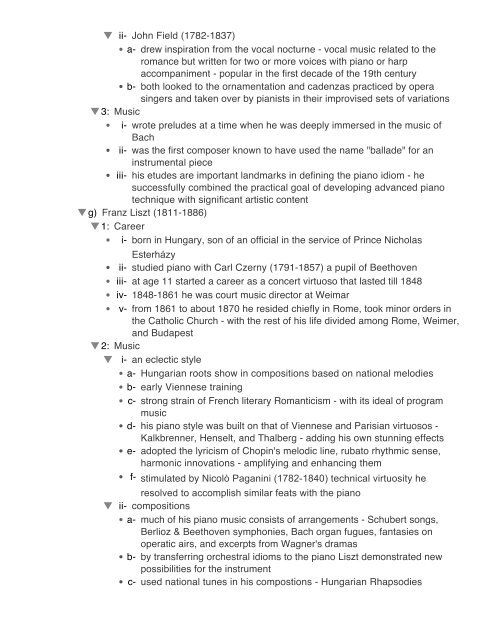An Outline of The History of Western Music Grout ... - The Reel Score
An Outline of The History of Western Music Grout ... - The Reel Score
An Outline of The History of Western Music Grout ... - The Reel Score
You also want an ePaper? Increase the reach of your titles
YUMPU automatically turns print PDFs into web optimized ePapers that Google loves.
ii- John Field (1782-1837)<br />
a- drew inspiration from the vocal nocturne - vocal music related to the<br />
romance but written for two or more voices with piano or harp<br />
accompaniment - popular in the first decade <strong>of</strong> the 19th century<br />
b- both looked to the ornamentation and cadenzas practiced by opera<br />
singers and taken over by pianists in their improvised sets <strong>of</strong> variations<br />
3: <strong>Music</strong><br />
i- wrote preludes at a time when he was deeply immersed in the music <strong>of</strong><br />
Bach<br />
ii- was the first composer known to have used the name "ballade" for an<br />
instrumental piece<br />
iii- his etudes are important landmarks in defining the piano idiom - he<br />
successfully combined the practical goal <strong>of</strong> developing advanced piano<br />
technique with significant artistic content<br />
g) Franz Liszt (1811-1886)<br />
1: Career<br />
i- born in Hungary, son <strong>of</strong> an <strong>of</strong>ficial in the service <strong>of</strong> Prince Nicholas<br />
Esterházy<br />
ii- studied piano with Carl Czerny (1791-1857) a pupil <strong>of</strong> Beethoven<br />
iii- at age 11 started a career as a concert virtuoso that lasted till 1848<br />
iv- 1848-1861 he was court music director at Weimar<br />
v- from 1861 to about 1870 he resided chiefly in Rome, took minor orders in<br />
the Catholic Church - with the rest <strong>of</strong> his life divided among Rome, Weimer,<br />
and Budapest<br />
2: <strong>Music</strong><br />
i- an eclectic style<br />
a- Hungarian roots show in compositions based on national melodies<br />
b- early Viennese training<br />
c- strong strain <strong>of</strong> French literary Romanticism - with its ideal <strong>of</strong> program<br />
music<br />
d- his piano style was built on that <strong>of</strong> Viennese and Parisian virtuosos -<br />
Kalkbrenner, Henselt, and Thalberg - adding his own stunning effects<br />
e- adopted the lyricism <strong>of</strong> Chopin's melodic line, rubato rhythmic sense,<br />
harmonic innovations - amplifying and enhancing them<br />
f- stimulated by Nicolò Paganini (1782-1840) technical virtuosity he<br />
resolved to accomplish similar feats with the piano<br />
ii- compositions<br />
a- much <strong>of</strong> his piano music consists <strong>of</strong> arrangements - Schubert songs,<br />
Berlioz & Beethoven symphonies, Bach organ fugues, fantasies on<br />
operatic airs, and excerpts from Wagner's dramas<br />
b- by transferring orchestral idioms to the piano Liszt demonstrated new<br />
possibilities for the instrument<br />
c- used national tunes in his compostions - Hungarian Rhapsodies<br />
3: Liszt experimented with harmonies that surprisingly anticipate late 19th & 20th<br />
century developments





